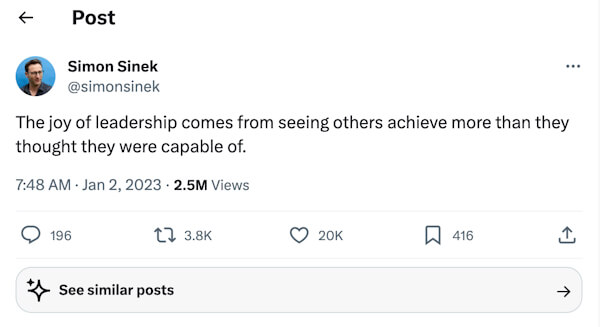You’re the expert in your field, and your stellar performance has propelled you to the top.
But as you take your seat at the head of the table, a nagging question begins to surface: “Am I ready to lead an organization?”
Leadership is not an automatic transfer of skills; it’s a profound transformation that requires new abilities, perspectives, and support.
The harsh reality is that many newly minted leaders find themselves adrift in uncharted waters.
Their technical prowess may be unmatched, but leading an organization requires an entirely different skill set.
Without the proper guidance, training, and mindset, these leaders often falter, affecting not only their confidence but also the entire organization’s success.
It’s not about abandoning expertise but expanding horizons to embrace strategic thinking, team development, and organizational growth.
Thriving as a leader goes beyond managing projects or teams; it’s about steering the entire organization toward success.
The most important thing I can say, and I believe with all my heart, is that executive leadership is more about building leaders than leading an organization.
Unfortunately, many organizations overlook the critical transition from expert to leader, leaving a gap in skills, understanding, and support.
A lack of awareness and investment in leadership development leads to underprepared and struggling leaders.
Organizations (especially those who see leadership as a ‘soft skill’) fall into this trap because they:
- Misunderstand leadership as an extension of technical expertise
- Fail to provide adequate training and mentorship
- Ignore the importance of strategic thinking and vision
- Neglect the essential task of cultivating leaders at all levels
You can make the leap from expert to exceptional leader, armed with the right tools, mindset, and support.
Here’s how:
Step 1: Embrace Your New Role with Openness and Curiosity
This might be a challenge but set the ego aside. Recognizing that leadership requires new skills and perspectives sets the stage for growth and success.
Here’s a truth you can embrace. You don’t have to have all the answers to be a good leader. Seasoned leaders understand this.
Newer leaders, not so much.
Step 2: Seek Training, Support, and Mentorship
Assuming that leadership skills will naturally develop can lead to frustration and failure.
Investing in leadership programs, coaching, and peer support ensures a smoother transition and ongoing success.
I’ll go so far as to say that you might be in the wrong place if you’re in an organization that isn’t investing in leadership as much as they’re investing in technical skills.
Step 3: Cultivate a Vision and Develop Leaders Within
Building a strategic vision and nurturing leaders at all levels creates a resilient and thriving organization.
Not to mention a fail-safe succession plan. If you do this right, you’ll never have to do an outside search for your next executives.
Step 4: Build Leadership Resilience
Leadership resilience is about enduring and growing from the challenges and pressures that come your way.
It starts with self-care to prevent executive burnout. Reserve time for activities that recharge you, whether that’s a workout, meditation, or an engaging book.
Beyond personal care, cultivate a culture that views setbacks as learning experiences, not failures. Make it a point to foster a supportive atmosphere, encouraging your team to voice concerns and navigate obstacles collectively.
Lastly, embrace ongoing learning. Business landscapes change; your resilience will depend on your willingness to adapt.
This isn’t just about staying updated with industry trends; it’s about questioning your existing beliefs and methods. Remember, resilience is a skill, not a trait; like any skill, it requires continuous development.
Building the Leadership Bench: The Heart of Organizational Strength
Navigating the journey from expert to leader is pivotal not just for personal growth but for building a resilient organizational structure.
It’s about cultivating a leadership bench that fuels innovation, enhances agility, and assures seamless succession planning.
By embracing this philosophy, organizations lay the groundwork for a future that’s marked by continuous growth, cohesion, and excellence.
Summary:
Whether you’re stepping into a new leadership role or nurturing leaders within your organization, embracing leadership as a full-time job is the key to unlocking untapped potential and success.


